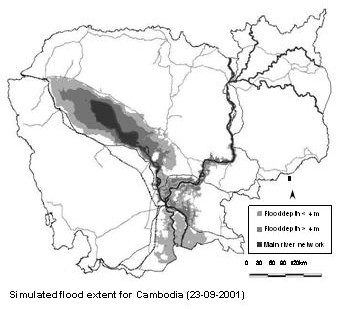The resilience concept in flood risk management for the lowland part of the Mekong River
The Mekong River is situated in South East Asia and can be considered one of the few large rivers in the world that are still almost in their natural state. The lowland part of the Mekong River falls within the borders of Cambodia and is characterised by long-lasting floods during the monsoon period. As a consequence of these recurrent floods, the vast floodplains of Cambodia abound in natural resources and provide good conditions for human settlement. Most Cambodians are employed in the agricultural and fishery sector and live in close harmony with the river. Every once in a while, however, extreme floods cause considerable loss of life and property. These devastating floods have a strong negative impact on the long-term sustainable development of the region.

A reduction in flood risk can be achieved by means of appropriate flood risk management. Flood risk management strategies can be developed from two different perspectives: resistance and resilience. Resistance strategies aim at a reduction of the frequency of flooding, while strategies based on resilience focus on minimising the impact of floods and enhancing recovery after a flood. Fairly recently, the concept of resilience in flood risk management has been quantified by means of four resilience indicators. So far, however, there is still a lack of experience with these indicators. The lowland part of the Mekong basin provides a very interesting testing ground for the resilience concept, since life and functions are strongly interwoven with regular floods.
The objective of this study was to apply the resilience concept to the lowland part of the Mekong River and evaluate flood risk management strategies for this area.
While conducting the study, it was established that the resilience indicators adequately correspond with the expectations beforehand. However, in a resilient system, such as the lowland part of the Mekong basin, the relationship between flood parameters and flood impact is very complex. Due to the close interaction between the socio-economic and the natural system, the system’s reaction to floods is expected to be influenced by previous flood years.
The evaluation of conceptual flood risk management strategies showed that resilience strategies are very suitable for flood risk management in the lowland part of the Mekong River. Non-structural measures are capable of mitigating the devastating aspects of floods while preserving their environmental benefits. However, more flood regulation by means of structural measures could encourage further economic development. For the lowland part of the Mekong River, such measures should not be aimed at the reduction of the flood extent but rather at the regulation of the floodwater, to serve the flood dependency of important user functions.
Begeleiders:
Prof. E. van Beek (TU Delft), Prof.dr. H.H.G. Savenije (TU Delft), ir. K.M. de Bruijn (TU Delft), Dr. W. Douven (IHE), ir. J.P.M. Dijkman (WL)